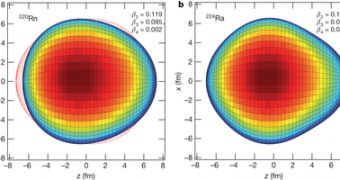Scientists have found direct evidence of pear-shaped atom nuclei, a discovery that should further the search for an explanation of the imbalance between matter and antimatter in nature.
According to the Standard Model, our best theory yet on how the universe works, equal amounts of matter and antimatter should have been created in the Big Bang. The matter and antimatter should have annihilated itself shortly after.
The fact that our universe is largely made up of matter is obvious evidence that our current understanding of what happened in the early days is incomplete.
Some processes that produce an unequal amount of matter and antimatter have been discovered, but they don't explain the full discrepancy.
This is why physicists are looking at interactions beyond the four explained by the Standard Model. And asymmetric atom nuclei make it a lot easier to study the effects of this fifth type of interaction, if it indeed exists.
Researchers found that the nuclei of heavy atoms, such as those of radium and radon, are pear-shaped, rather than the typical spherical or ellipsoidal nuclei of most atoms. The results of the research have been published in Nature.
This asymmetry is explained by the nuclear forces at work which aren't spherically symmetric like gravity. In pear-shaped nuclei, positively-charged protons are pushed to the side.
The way neutrons and protons are distributed in the nuclei of these atoms, compared to the axis of spin, could be a clue to how this new interaction, again, if it exists, works.
It's still a long way from any new discovery, but the simple fact that these atoms exist and that they have been observed is enough to go on.
"The new interaction, whose effects we are studying does two things," Tim Chupp, a University of Michigan professor of physics explained. "It produces the matter/antimatter asymmetry in the early universe and it aligns the direction of the spin and the charge axis in these pear-shaped nuclei."

 14 DAY TRIAL //
14 DAY TRIAL //